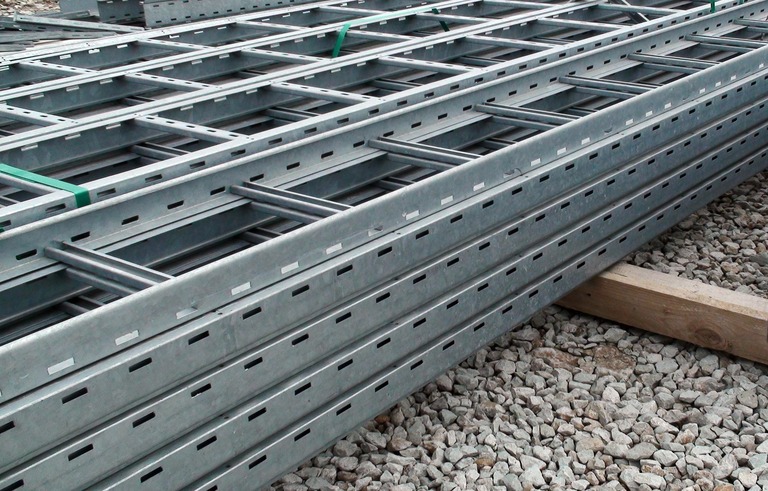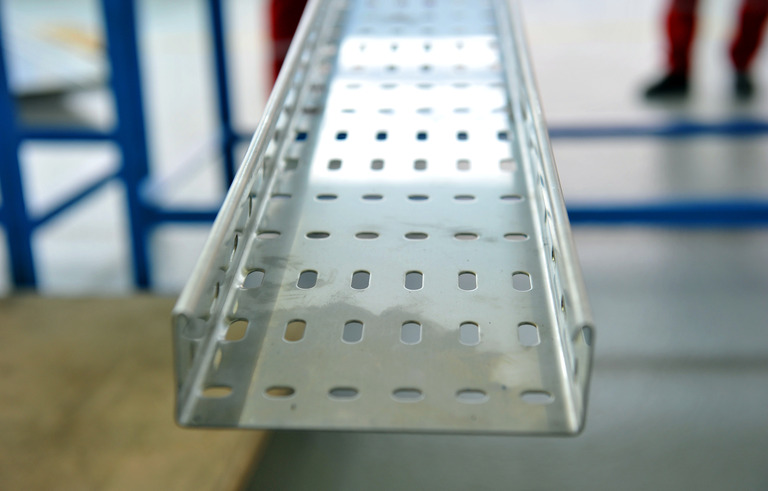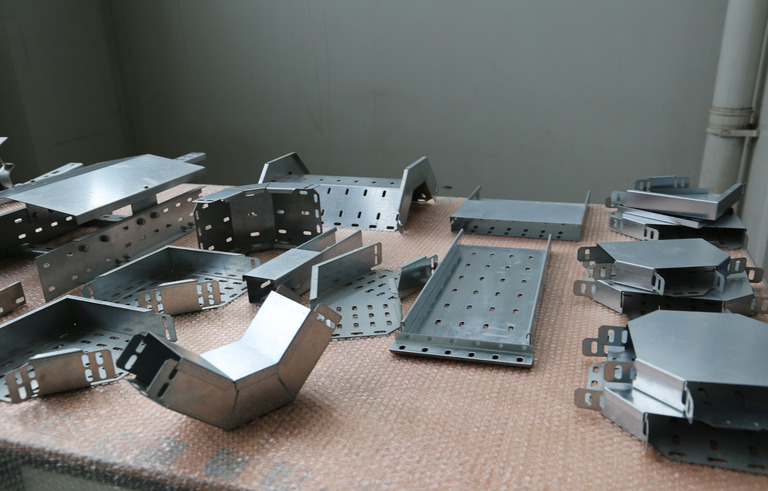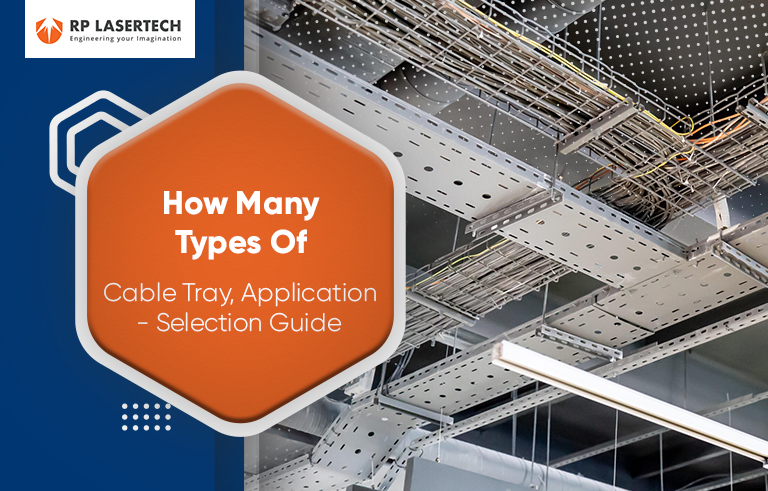Choosing cable trays for your engineering project can be challenging when many options are available. The options are quite varied but don’t get overwhelmed. You’ll learn about the types of cable trays and how to choose the right cable tray for your project. The types of cable tray fittings and features offered by cable tray manufacturers also interest you.
What is a cable tray? What are its types?
Generally, cable trays are rigid structural systems used to fasten cables or trays securely.
During a connection between two points, cable trays are used to carry a large number of cables or conduit tubes. Environmental conditions and installation requirements must be considered when selecting a tray material.
Compared to electrical conduits, cable trays are safer, more reliable, improve space utilization, and are less expensive.
Ladder Cable Tray

Ladder trays (looks like ladders) are used primarily in feeder applications to carry multiple cables for longer runs with higher current carrying capacity. You can cut, shape, and fit ladder trays horizontally or vertically.
Characteristics:
- Long-span applications require solid rail protection and system strength with sleek radius fittings.
- The most common widths are 12 inches, 18 inches, 24 inches, 30 inches, and 36 inches.
- A typical depth is three, four, five, or half a dozen inches
- Ten, twelve, twenty, and twenty-four-foot lengths are common
- Inch spacing of half a dozen, nine, twelve, and eighteen rings.
Solid Bottom Cable Tray

Cables are protected to the maximum extent by the solid bottom tray. Solid bottom cable trays can reduce electromagnetic interference/radio frequency interference. A solid bottom cable tray is recommended for optical fiber installations where cable dropoff could adversely affect system performance.
Characteristics:
- Continual nonventilated cable support with accessory cable protection available on the market in gilded and covering materials
- In environmental areas, the bottom is solid, and the covers are solid metal for cable that is not plenum-rated
- There are common widths of half-dozen, 12, 18, 24, thirty, and thirty-six inches.
- There are three, four, five, and half-a-dozen common depths
- Typical lengths are 10, 12, 20 & 24 feet
Trough Cable Tray
Trays consisting of longitudinal side members and a ventilated or solid bottom are called trough trays. Solid bottom trough trays are used for transporting smaller instrumentation, computer equipment, telephones, control systems, and fiber optic cables between locations.
Characteristics:
- The ventilation is moderate, with accessorial cable support frequency at an all-time low, providing cable support every four inches.
- Available in metals and metalloids
- A half dozen, 12, 18, 24, 30, 36 & 36 inches are the most common widths
- Three, four, five, and half-a-dozen inches are typical depths
- ten, twelve, twenty, and twenty-four feet are typical lengths.
- Four-inch-on-center mounted rung spacing.
Channel Cable Tray

An effective way to support cable drops and branch cable runs from the backbone cable tray is through channel cable trays. When conduit cannot be used to install cable trays, channel cable trays are used.
Characteristics:
- The backbone cable receptacle system provides economical support for drop cable runs and branch cable runs
- commonplace widths of three, 4, & half-dozen inches in metal systems and up to eight inches in metalloid systems
- For metal systems, it is common to have a depth of 1-3/4 inches, and for metalloid systems, it is common to have a depth of 1,1-1/8 or 1-5/8 inches
- 10 feet, 12 feet, 20 feet, and 24 feet are the most common lengths.
Wire Mesh Cable Tray
Cable trays are used in all industries in data centers and office buildings of electronic data processing centers. It is less expensive to lay cables with mesh cable trays, also called cable baskets, by wire mesh cable tray manufacture.
Characteristics
- Field-adjustable website primarily for fiber optic cables, low voltage, and telecommunications applications.
- In these systems, steel wire mesh is usually plated with atomic number 30
- There are commonly available widths of 2, 4, 6, 8, 12, 16, 18, twenty & twenty-four inches
- One, two, and four inches are common depths
- Ten feet is a common length.
How to choose a cable tray?
Cable tray manufacturers in India keep to the following factors for selection:
- The type and number of cables supported.
- Conditions in the environment: Will these cables have to be subjected to extreme weather or construction conditions?
- Possibility of corrosion
- Cable weights installed
- The radius of the bend in the cable and tray
- Cable entry and exit freedom What will the difficulty of running cables along the tray be?
- Installation is simple
- Expandability: Can an extra tray be easily added?
- The amount of heat produced
- The length of the support spans
Standards
The National Electrical Manufacturers Association (NEMA) produces a variety of documents about cable tray.
-
- NEMA VE1 covers general cable tray specifications, manufacturing standards, and performance criteria.
- NEMA VE2 is an installation guideline for cable tray installations.
- NEMA FG1 covers the fiberglass cable tray systems.
- The National Electrical Code (NEC), specifically Articles 250, 318, 392, and 800, also cover different aspects of cable trays.
- An electrical cable tray may be classified as UL-certified if used as an equipment grounding conductor. Underwriters Laboratory (UL) and American National Standards Institute (ANSI) maintain ANSI/UL568 for non-metallic cable tray systems.
- UL 568: Monmetallic Cable Tray Systems
- Fiberglass cable trays can be utilized to comply with ASTM E-84 and ASTM D-635 (flame rating and self-extinguishing criteria) (smoke density rating).
- The National Electrical Contractors Association (NECA) has standards for the installation of cables in a tray made of metal:
- The standard for Installing Metal Cable Tray Systems (NECA NEIS 105)
Conclusion
For more information on cable tray application, installation, and materials, get in touch with a cable tray manufacturer near me!
Cable trays manufactured by RP Lasertech are known for their various qualities, like resistance to corrosion, durability, and long-lasting performance. They also allow customers to purchase from them at top costs. We are here to assist you.


